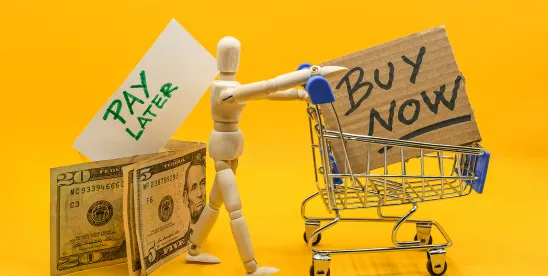Each year, upwards of 100,000 music fans pay up to $599 for the ticket price of weekend-long admission to the Coachella Music and Arts festival outside of Palm Springs, California. In 2025, however, nearly 60% of Coachella’s general admission ticket buyers turned to an increasingly ubiquitous short-term loan service to finance the steep cost of admission: Buy Now, Pay Later (“BNPL”). BNPL financial services typically allow consumers to split purchases into four or fewer interest-free installments, often without a traditional credit check. The organizers of Coachella, for example, partnered with a ticketing provider AXS to provide BNPL options allowing festival attendees to purchase tickets for as little as $49.99 up front with the remaining costs due in installments over the next several months.
In the past decade, BNPL services have reshaped the way consumers shop. Fintech firms like Klarna, Affirm, and Afterpay offer flexible, interest-free BNPL payment-plan options that are embedded in everything from retailer e-commerce check-outs, payments for delivery services like DoorDash, and in-store purchasing kiosks. In 2022, the CFPB estimated that 21% of U.S. consumers with a credit record financed at least one purchase using BNPL from top fintech firms in 2022, and that 20% of those users could be characterized as “heavy users” who take up one BNPL loan on average per month. But as adoption has accelerated, so too has scrutiny from regulators.
What Is BNPL and Why Does It Matter?
BNPL financial products generally have three features that distinguish them from standard consumer lines of credit: (1) the products are structured as short-term installment loans with a minimal down payment due at the time of sale, (2) the loans are offered by retailers and ordinally tied to the purchase of a particular product or service, and (3) the terms of the loan are generally more favorable with no interest payments and limited fees. While the model offers convenience and flexibility, it also raises concerns about potential exposure resulting from inadequate fee and term disclosures, overextension of credit, and minimal underwriting standards. These issues have prompted increased attention from both regulators and consumer advocates.
Regulatory Oversight: A Shift in Direction
Initially, the Consumer Financial Protection Bureau (CFPB) took an aggressive stance toward BNPL services. In 2022, the CFPB published a comprehensive report identifying consumer protection gaps in the BNPL market. By 2024, the CFPB issued an interpretive rule under the Truth in Lending Act (TILA) that classified BNPL financial products as “credit cards,” thus subjecting BNPL providers to requirements under Regulation Z (subpart B) including issuing cost-of-credit disclosures and billing statements, and investigating consumer disputes. In 2025, however, the CFPB reversed course under new leadership. In March 2025, the CFPB indicated in a court filing that it intended to withdraw the BNPL interpretive rule in March 2025. Shortly thereafter, the agency also announced it would not prioritize BNPL enforcement. No replacement rule is expected, leaving federal oversight in a state of uncertainty.
With the CFPB stepping back, states have been filling the regulatory vacuum. In June 2025, New York enacted as part of its budget for the 2025-2026 fiscal year the Buy-Now-Pay-Later Act (Article 14-B of the Banking Law), which establishes a comprehensive regulatory framework for BNPL providers. The law requires BNPL providers to obtain a license from the New York Department of Financial Services (NYDFS) to operate in the state, assess a consumer’s ability to repay before issuing credit, cap fees and interest rates, and make disclosures similar to those required under Regulation Z. The law also sets data privacy standards and grants NYDFS broad authority to enforce compliance with the law. In addition, California has, since 2020, classified BNPL products as “loans” under the California Financing Law and requires BNPL providers to obtain license to operate in the state. Other states have considered similar regulations applicable to BNPL services and are likely to follow suit.
Emerging Legal Risks: What’s Next?
In June 2025, FICO, whose credit scores are used by 90% of U.S. lenders, announced that it would introduce two new credit scoring models in Fall 2025 that incorporate a consumer’s BNPL payment history. While this development will provide lenders with a more complete picture of consumer credit behavior, it also introduces new legal risks for BNPL providers and retailers.
BNPL products are disproportionately used by younger, lower-income, and minority consumers. If credit outcomes worsen for these groups of consumers because of BNPL financial products, businesses may face additional regulatory scrutiny from states even if federal regulators have, for the time being, stepped back enforcement. Moreover, plaintiffs’ attorneys may pursue class actions alleging harm from inaccurate reporting to credit agencies or failure to disclose credit implications.
As BNPL financial products becomes more integrated into the credit ecosystem, BNPL fintech firms and retailers using BNPL services should proactively assess their data governance practices, consumer disclosures, and dispute resolution protocols to mitigate these potential future regulatory and litigation risks.



 />i
/>i

